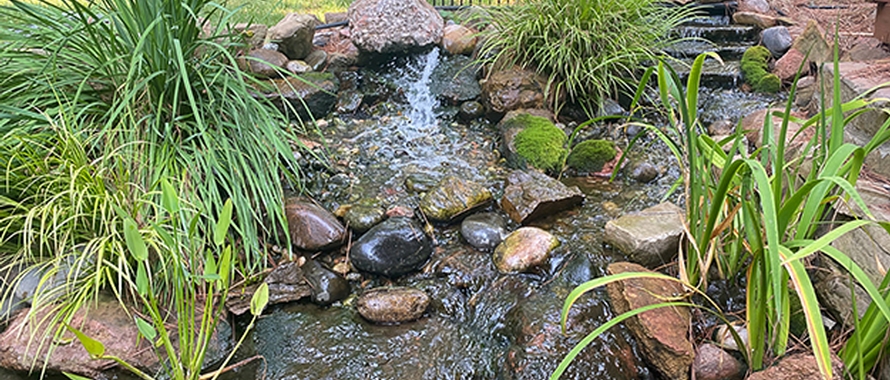Pond Reflections
Building and maintaining a water garden

Have you always wanted a pond? If so, here’s how we built ours and eventually brought it into beautiful balance.
In 2015, three weeks before the Oklahoma Horticulture Society’s fall garden tour, my husband, Bill, announced he wanted a pond. Neither one of us knew how to care for one, but I knew water gardens were high maintenance and thought having one wasn’t worth the work.
I was wrong. Our pond gives us reflective beauty, soothing sounds and increased wildlife. It may be work, but it’s also the most peaceful place in the garden to rest.
To make it more natural looking, Bill built our water garden into a hill. We built an earthen dam and put a small retaining wall around the edge to prevent debris and ground water from entering the pond. We then used a pond liner to create the floor and sides and covered the walls with rocks.
For easiest care, ponds should be located in the sun to minimize leaves and other debris. Our pond is beneath an oak branch and next to a loblolly pine. It looks lovely with the overhanging branch, and over time we learned how to keep most of the leaves and pine needles out of the water. In winter, we cover the entire surface area with netting, which also discourages predators from eating our goldfish.
For the fall garden tour, the pond looked great, but the following spring, it didn’t look so good. Using netting to trap leaves and other debris really helped.
To combat string algae, we use UV lights and natural barley extract. You can also use dyes to prevent excess algae, but remember that some algae is a natural part of your pond’s ecosystem. Each week on Sunday afternoon, I work to clear out pine needles and remove string algae from our rock waterfalls. I don’t mind the maintenance because it is nice and cool in summer. We also have two bubblers at the still end of the pond to keep the water aerated. We clean our filters at least once a week.
Ponds increase beauty and wildlife in the landscape. In spring, frogs come early and often stay active until late fall. They are quite noisy during mating season in March and April. I mention this because our pond is outside our bedroom door. Things settle down after the tadpoles come. If you have fish, you’ll have predators like snakes, raccoons and birds, and you’ll need a plan to keep them away. Some people use netting or fishing line depending upon the type of predator. We don’t remove our netting until plants that shade the water and help hide the fish get growing in late spring. We try to cover over half of the pond’s surface area with plants. We also built a shelf for the fish to hide beneath.
My favorite water garden plants are sacred lotus, elephant ears, papyrus, pickerel, water lilies—which need to be placed in the sun and away from moving water to bloom well—and Louisiana iris. Before adding any plants to your pond, check with your local aquatic nursery or online at the Oklahoma Biological Survey so you don’t install an invasive plant like yellow flag iris, I. pseudacorus.
A successful water garden is all about the balance of plants, water, bacteria and fish. I’ve come to love our pond because of the dragonflies and other creatures it brings to our landscape. For us, the pond is worth the maintenance for the pleasure it provides. Perhaps, you’ll think so too.
Sign up for our Oklahoma Living Newsletter


